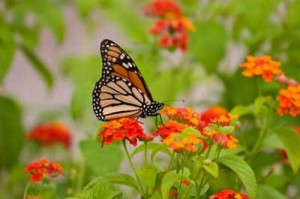Here is some excellent advice for butterfly gardeners from Kelly Greer, Orange County Extension Agent for Residential Horticulture and Florida-Friendly Landscaping™ Program:

There has been much discussion about a recent scientific study (Satterfield et al., 2015). This research shows very clearly that monarchs breeding on tropical milkweed (Asclepias currasavica) throughout the winter have higher levels of protozoan infection (caused by Ophryocystis elektroscirrha, OE) compared to monarchs in the migratory cycle. Monarchs are healthier when milkweed is seasonal. Below are recommendations for gardeners interested in reducing monarch disease and non-migratory behaviors.
- Plant native milkweeds whenever possible and gradually replace your tropical milkweed with native species.
- If you have tropical milkweed, cut it back from October-February to within 6″ of the ground. Also, remove any new plant growth at the base of the plant; it will be necessary to prune frequently (every 3 weeks) as it re-grows.
- Learn to identify native milkweeds and protect them.
- Ask local growers to produce native milkweeds.
- Participate in research efforts through organizations listed below.
Monarch Health: http://monarchparasites.org/
Monarch Larva Monitoring Project: http://mlmp.org/
Monarch Watch http://monarchwatch.org/
Journey North: http://www.learner.org/jnorth/monarch/
 0
0
